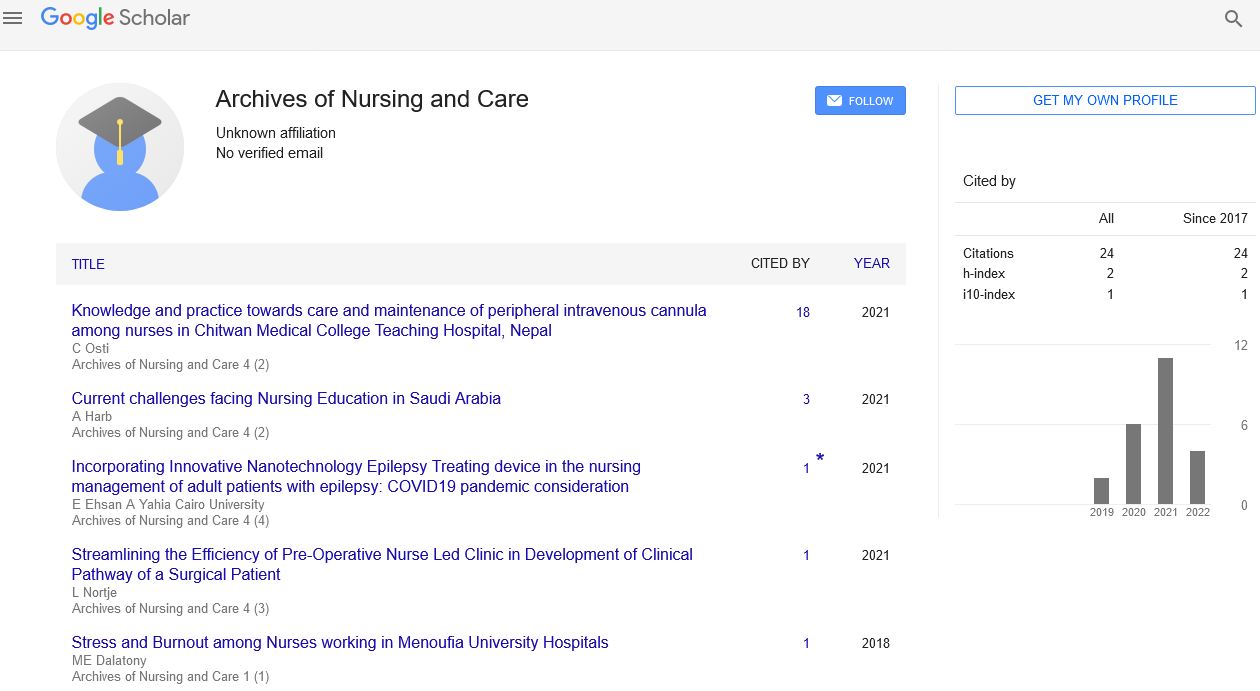Review Article - Archives of Nursing and Care (2023) Volume 6, Issue 3
Nursing Care: Effects of Social Isolation and Loneliness on Health Service after a Cardiovascular Disease
Rosie Felia*
Department of Epidemiology and Preventive Medicine, School of Public Health & Preventive Medicine, Monash University, Melbourne, VIC, Australia
Department of Epidemiology and Preventive Medicine, School of Public Health & Preventive Medicine, Monash University, Melbourne, VIC, Australia
E-mail: Feliarosie@edu.it.au
Received: 02-June-2023, Manuscript No. OANC-23-96753; Editor assigned: 05-June-2023, PreQC No. OANC-23- 96753 (PQ); Reviewed: 19-June-2023, QC No. OANC-23-96753; Revised: 26-June-2023, Manuscript No. OANC-23- 96753 (R); Published: 30-June-2023; DOI: 10.37532/oanc.2023.6(3).71-73
Abstract
Social isolation, the relative absence of or infrequency of contact with different types of social relationships, and loneliness are associated with adverse health outcomes. Evidence is most consistent for a direct association between social isolation, loneliness, and coronary heart disease and stroke mortality. However, data on the association between social isolation and loneliness with heart failure, dementia, and cognitive impairment are sparse and less robust. Given our evidence, the first step to improve cardiac outcomes is acknowledging that social health is part of the decision-making process. Incorporating a formal assessment of social support into healthcare management plans will likely improve cardiac outcomes and survival. Further research is required to assess if support person/s need to engage in the risk reduction behaviours themselves for outpatient rehabilitation to be effective. Further synthesis of the impact of social isolation and loneliness on health service utilization and survival after a CVD event is required. Social isolation and loneliness are common and appear to be independent risk factors for worse cardiovascular and brain health; however, consistency of the associations varies by outcome. There is a need to develop, implement, and test interventions to improve cardiovascular and brain health for individuals who are socially isolated or lonely. The role of social isolation, loneliness, and other social determinants in shaping cardiovascular and brain health outcomes is well established. Social isolation is defined as the objective state of having few or infrequent social contacts. Loneliness is perceived isolation that is distressing for the individual. Although related, they are distinct constructs that operate through different pathways and have unique downstream effects on health.
Keywords
Social isolation • Nursing care • Health service • Cardiovascular disease
Introduction
Cardiovascular disease (CVD) is the leading cause of death globally and carries a high economic burden, which is driven largely by productivity and direct healthcare costs. It is essential to identify factors that influence health service utilisation and subsequent CVD events, to mitigate the significant health and economic burden of CVD. Poor social health is a modifiable risk factor for CVD and mortality and also carries a high health and economic burden. Social health refers to a person’s ability to form fulfilling, meaningful relationships; a person’s ability to adapt in social situations; and support from other people, institutions, and services. The concepts of social isolation, loneliness, and social support are often discussed in relation to social health. How these concepts are defined can be beneficial for cardiovascular disease patients. Social isolation can be defined as an objective measure of the number or quantity of social connections. Social support can be defined as a subjective measure of how social connections are operationalized, while loneliness can be defined as a subjective negative experience related to isolation or lack of social support [1]. There is a depth of research describing different facets of these social health concepts. Social isolation has been described as having a perceptive component based on experience over the life course, for example, family role-modeling socializing behaviours, family dynamics, and long-term patterns of socialisation. The perceptive component then impacts the objective measurement of the number of social contacts or social relationships. Hence, the social isolation could be argued to also be subjective based on personal history and expectations. Similarly, loneliness has been described as having two components. Social loneliness is related to a subjective lack of social isolation the quantitative aspect of loneliness, that is, the subjective lack of a broader support network. Emotional loneliness is related to a subjective lack of social support described as a subjective feeling of detachment, thereby representing a qualitative aspect of loneliness pertaining to the lack of deep and meaningful relationships. Further, social support is not always a positive experience and can be separated into positive and negative support. Family dynamics, personal expectations and communicative norms, for example, can have negative emotional, behavioural and cognitive consequences. People can feel that the support is unhelpful or creates social constraints [2].
Materials and Methods
The initial aim of the systematic review was to assess the influence of social health on a CVD patient’s journey. The initial searches supplied >1 million potential papers. Following the preferred methodology to reduce the threat to validity from bias and confounding, we restricted based on country. Australia and New Zealand were chosen due to the health care system that is common and reciprocated in many countries [3].
The second iteration of the search resulted in >10 outcomes of interest, as we had not predefined these. To ensure adequate discussion of each outcome, we split the outcomes over two reviews. The other review focuses on the influence of social health on a CVD patient’s health, including physical health, mental health and quality of life. The main finding was that greater social health was consistently associated with better mental health outcomes among cardiac patients; the review did not assess health service utilization [4].
Risk and Protective Factors Risk and protective factors for social isolation and loneliness have been well described. These include predisposing physical health conditions, psychological and cognitive factors, and socio environmental factors. Some of these factors increase the risk for adverse health effects, whereas others lower the risk. In addition, there is a bidirectional relationship between risk factors and social isolation or loneliness [5]. For example, depression may lead to social isolation, and social isolation may make an individual more likely to experience depression. Certain populations are at higher risk for social isolation and CVD based on socio demographic characteristics such as race and ethnicity, sexual orientation, gender identity, socioeconomic status, and social status, or place of residence. However, research on health effects of social isolation and loneliness within these special populations is sparse [6]. Despite robust observational literature, we did not identify any intervention studies that sought to mitigate the adverse impact of social isolation or loneliness on cardiovascular or brain health specifically. Therefore, we focus this section on interventions that have primarily aimed to reduce social isolation and loneliness among older adults. A review conducted by Cohen-Mansfield and Perach concluded that there was no solid evidence of efficacy of the interventions for older community-dwelling adults, highlighting the preliminary state of the science and the need for rigorous studies. The remaining 5 reviews focused on loneliness and other outcomes such as anxiety and depression or social participation and social connectedness [7]. Of interventions to reduce social isolation, physical activity interventions show the most promise in older adults. A meta-analysis found that interventions for loneliness that address maladaptive social cognition, negative thoughts of self-worth, and other people’s perception of the individual rather than interventions involving strengthening social support or increasing social interactions, have been the most successful [8]. Despite suggestions that technology may be a promising strategy to mitigate social isolation and loneliness, evidence is mixed. A review of systematic reviews of internet/computer e-interventions to reduce loneliness in older adults living in residential settings or nursing homes found insufficient support for any impact on loneliness. This review confirmed the poor quality of evidence, largely driven by study designs unable to determine causation. A recent Cochrane review also found little evidence for the effectiveness of video call interventions to reduce loneliness in older adults. In contrast, in another review of interventions to reduce loneliness and social isolation, results were mixed, with some, but not all, reporting significant improvement in loneliness or social isolation. Interventions implemented within complex programs, and incorporating various approaches appeared most successful. However, most of the studies had poor-quality designs with significant threats to internal validity, including selection bias [9].
Social isolation and loneliness are common, yet under recognized determinants of cardiovascular health and brain health. Overall, findings suggest an increased risk of worse outcomes among individuals with prevalent CHD and stroke in those who are also socially isolated or lonely [10]; however, these studies do not suggest causality, and associations may be mediated by other factors that need to be further tested in intervention.
Conclusion
Our systematic review expands the prior reviews by demonstrating that greater social health is associated with better mental health among cardiac patients. Further research is required to evaluate interventions aimed at improving social health among cardiac patients to alleviate the healthcare system burden. As both CVD and social health carry high economic burdens, interventions in this subgroup will likely have manifold economic benefits through improved mental health and lower healthcare utilization. In addition, we identified that, among Australian and New Zealand cardiac patients, lower social isolation and higher social support were generally associated with patients reporting that their needs were met. Living situation was not associated with mental health outcomes, while being married or living with someone was associated with medication adherence. As partner status and living status did not align with social support and social support findings in this review, we recommend they not be used as social health proxies when assessing health outcomes among CVD patients. Our review highlights the need for more research focused on women and the importance of gender-disaggregated reporting. Further assessment is required to evaluate whether loneliness is associated with health and well-being outcomes after a CVD event.
References
- Banci L, Ciofi-Baffoni S, Tien M Ligninet al.Peroxidase-catalyzed oxidation of phenolic lignin oligomers.Biochemistry. 38, 3205-3210 (1999).
- Deblonde T, Cossu-Leguille C, Hartemann Pet al.Emerging pollutants in wastewater: A review of the literature.Int J HygEnviron Heal. 214, 442-448 (2011).
- Tavakoli M, Emadi Z.The Relationship between Health-Promoting Lifestyle, Mental Health, Coping Styles and Religious Orientation among Isfahan University Students.J Res Behave Sci. 13, 64-78 (2015).
- Norouzinia R, Aghabarari M, Kohan Met al.Health promotion behaviors and its correlation withanxietyand some students’demographic factors of Alborz University of Medical Sciences.Journal ofHealthPromotion Management. 2, 39-49 (2013).
- Mintz AH, Kestle J, Rathbone MPet al.A randomized trial assess the efficacy ofsurgerytoradiotherapyin patients with a singlebrainmetastasis.Cancer. 78, 1470–1476(1996).
- Zimm S, Wampler GL, Stablein Det al.Intracerebral metastases in solid-tumor patients: naturalhistoryand results of treatment.Cancer.48, 384–394(1981).
- Tsunoda S, Kamada H, Yamamoto Yet al.Molecular design of polyvinylpyrrolidone-conjugated interleukin-6 for enhancement of in vivo thrombopoietic activity in mice.J Control Release68, 335-341(2000).
- Norouzinia R, Aghabarari M, Kohan Met al.Health promotion behaviors and its correlation withanxietyand some students’demographic factors of Alborz University of Medical Sciences.Journal ofHealthPromotion Management. 2(4), 39- 49(2013).
- Pierce C.Health promoting behaviors of rural women with heart failure.Online Journal of RuralNursingandHealthCare. 5(2), 28-37(2005).
- Grunfeld E, Coyle D, Whelan Tet al.Family caregiver burden: results of a longitudinal study of breastcancer patientsand their principal caregivers.CMAJ.170, 1795–1801(2004).
Indexed at,Google Scholar,Crossref
Indexed at,Google Scholar,Crossref
Indexed at,Google Scholar,Crossref
Indexed at,Google Scholar,Crossref
Indexed at,Google Scholar,Crossref
Indexed at,Google Scholar,Crossref

